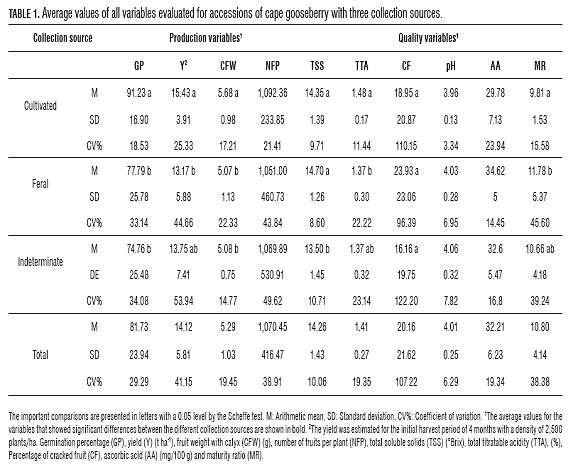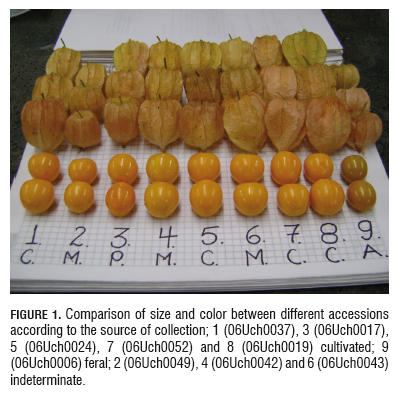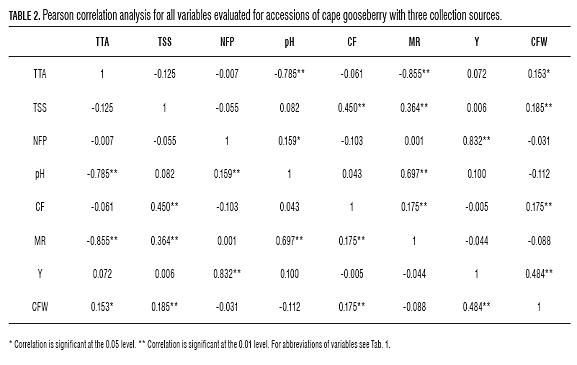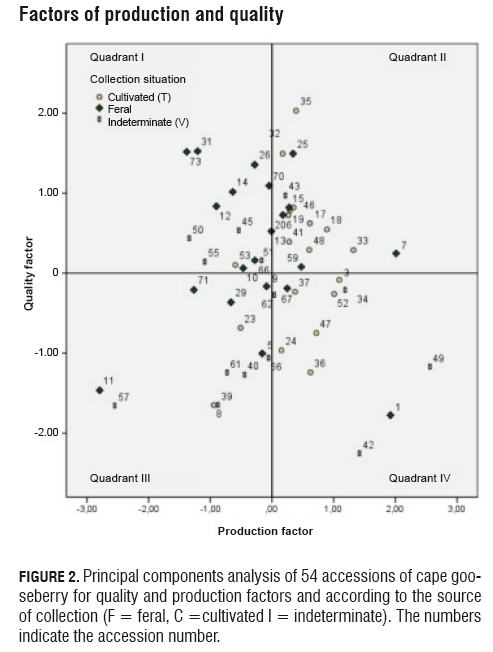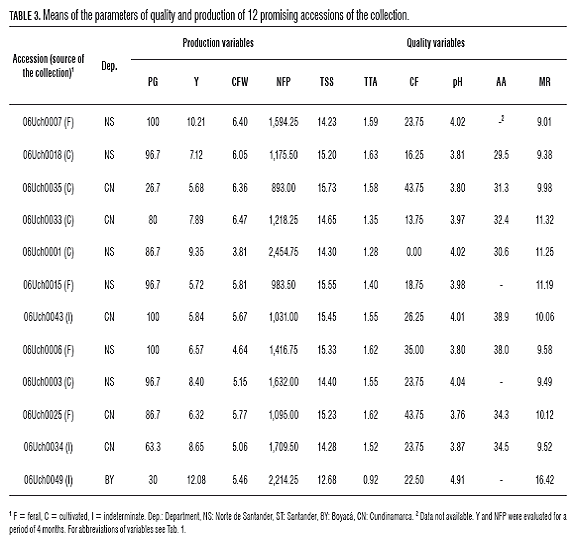Services on Demand
Journal
Article
Indicators
-
 Cited by SciELO
Cited by SciELO -
 Access statistics
Access statistics
Related links
-
 Cited by Google
Cited by Google -
 Similars in
SciELO
Similars in
SciELO -
 Similars in Google
Similars in Google
Share
Agronomía Colombiana
Print version ISSN 0120-9965
Agron. colomb. vol.29 no.2 Bogotá June/Aug. 2011
PLANT BREEDING, GENETIC RESOURCES & MOLECULAR BIOLOGY
Behavior in yield and quality of 54 cape gooseberry (Physalis peruviana L.) accessions from north-eastern Colombia
Comportamiento en producción y calidad de 54 accesiones de uchuva (Physalis peruviana L.) provenientes del nor-oriente colombiano
Axel M. Herrera M., 1,Julián D. Ortiz A.1, Gerhard Fischer1, and María I. Chacón S.1, 2
1Department of Agronomy, Faculty of Agronomy, Universidad Nacional de Colombia. Bogota (Colombia).2Corresponding author. michacons@unal.edu.co Received for publication: 22 November, 2010. Accepted for publication: 2 June, 2011.
ABSTRACT This study evaluated the performance in production and fruit quality of 54 accessions of cape gooseberry collected from plants that were cultivated, feral and indeterminate from the north-east. The experiment was carried out using a completely randomized design with four replicates per accession in a greenhouse. We estimated the germination percentage (GP) for 30 seeds per accession and with a random sampling of 20 fruits at 120 days after the beginning of harvest (dah), weight of the fruit with calyx (CFW), percentage of cracked fruit (CF), number of fruits per plant (NFP) and yield (Y), were determined and at 105 dah total soluble solids (TSS), total titratable acidity (TTA), maturity ratio (MR = TSS/TTA), pH and ascorbic acid (AA) were evaluated. Significant differences were observed in GP, Y and CFW with the highest values recorded at 91.23%, 6.17 kg/ plant and 5.68 g, respectively. For the variables TSS and CF, feral materials showed the highest values with 14.7°Brix and 23.93%, respectively. The results suggest the presence of significant variability in the cape gooseberry germplasm analyzed that can be incorporated into future conservation and breeding programs.
Key words: domestication, accession, germplasm variability, fruit.
RESUMEN
El presente estudio evaluó el comportamiento en la producción y calidad de fruto de 54 accesiones de uchuva colectadas en situación cultivada, asilvestrada e indeterminada provenientes del nor-oriente del país. Se estableció un experimento bajo un diseño completamente al azar con cuatro repeticiones por accesión en invernadero. Se estimó el porcentaje de germinación para 30 semillas por accesión y mediante una muestra de 20 frutos al azar y a los 120 días después del inicio de cosecha (ddc) se evaluó el peso de fruto con cáliz, porcentaje de rajado de fruto, número de frutos por planta y rendimiento, y a los 105 ddc se determinó los sólidos solubles totales, acidez total titulable, relación de madurez (sólidos solubles totales/acidez total titulable), pH y ácido ascórbico. Se observaron diferencias significativas en el porcentaje de germinación, rendimiento y peso de fruto con cáliz en donde los materiales cultivados registraron los mayores valores con 91,23%, 6,17 kg/planta y 5,68 g, respectivamente. Para las variables sólidos solubles totales y porcentaje de rajado, los materiales asilvestrados presentaron los mayores valores con 14,7°Brix y 23,93%, respectivamente. Los resultados sugieren la presencia de variabilidad importante en el germoplasma de uchuva analizado que puede ser incorporada en futuros programas de conservación y mejoramiento.
Palabras clave: domesticación, accesión, germoplasma, variabilidad, frutos.
Introduction
Colombia is the world's largest exporter of cape gooseberry (Physalis peruviana L.) because ecotype Colombia has excelled in the world market due to its characteristics such as sweet flavor, aroma and bright color (Agronet, 2010; Galvis et al., 2005). Furthermore, the large commercial acceptance and adaptive success that this species has exhibited has led to its wide distribution in different agro-ecological conditions in the Andes (Ligarreto et al., 2005), making it one of the most promising fruit for the development of the Colombian highlands.
Domestic production of the cape gooseberry grew at a rate of 42.6% between 1993 and 2008, with a production last year of 15,463 t and an average yield of 18.4 t ha-1, with the largest contributions coming from the departments of Boyaca, Cundinamarca and Antioquia with 36.3, 30.3 and 28.4%, respectively (Agronet, 2010). P. peruviana has 46% higher yields in the greenhouse, reaching production of 24 kg/plant for the first production cycle (10 months) (Angulo, 2005a). Its fruits can weigh between 4 and 10 g (Fischer, 2000) and its size ranges between 1.25 and 2.5 cm (National Research Council, 1989). For the export market, Colombia has made progress in implementing quality systems capable of meeting international requirements regarding the physio-chemical characteristics of the fruit, as well as those relating to homogeneity, presentation and health (Angulo, 2005b).
Fruit cracking presents the largest problem in terms of fruit quality for the cape gooseberry (Fischer, 2005). Cracking is especially serious in the first harvest, exacerbated possibly by the oversupply of assimilates common in these stages of plant development, resulting in a slight imbalance in the supply-demand relationship which increases pressure on the skin of the fruit (Gordillo et al., 2004; Torres et al., 2004). Besides the appearance of the fruit, other factors that are considered important in the commercial quality of the cape gooseberry are chemical aspects like the taste of the fruit (and /or juice), which is related to the maturity ratio (TSS/TTA) and the pH. The latter influences the industrial processing costs (Rodríguez et al., 2006). Márquez et al. (2009), by means of physio-chemical and sensory evaluations, found significant variations in the quality of fruits from 10 accessions of commercial cape gooseberry, which apparently were related to physiological and metabolic differences of each genotype.
The current commercial importance of the cape gooseberry demands a more tacit and extensive knowledge of the production characteristics and quality of Colombian material for this species, in order to efficiently increase and expand this vital market through the development of productive materials that better meet the specific needs of the targeted commerce. However, currently, such information does not exist or is lacking, which is why this study was designed to determine the productive performance and quality of fruit in a collection of 54 accessions of cape gooseberry (from plants that were cultivated, feral and undetermined) collected in the departments of Cundinamarca, Boyaca, Santander and Norte de Santander.
Materials and methods
Geographic location and conditions of the experiment We evaluated 54 accessions from the ex-situ germplasm bank of P. peruviana at the Faculty of Agronomy, Universidad Nacional de Colombia, Bogotá. Within these materials are 21 feral accessions (spontaneously occurring with small leaves, high serum, short internodes and an abundance of trichomes), 19 cultivated accessions (from fields and markets with large leaves, low serum, long internodes and a lower density of trichomes) and 14 indeterminate accessions (spontaneously occurring plants that cannot be allocated to one of the two previous categories), collected in the departments of Cundinamarca (21 accessions), Boyacá (13), Santander (5) and Norte de Santander (15).
We initially measured the germination percentage (GP) of 30 seeds per accession planted in trays of peat type 200 alveoli Klasmann® (oligotrophic peat, calcium carbonate, unfertilized) located in a greenhouse with plastic cover. Initial transplant was performed 50 days after planting (dap) in 1 L polyethylene bags, with a mixture of substrate, organic matter and sand (3:1:1). For the final field transplant 170 dap, four replicates per accession were performed with a total of 216 plants for the experiment planted at a distance of 2 x 2 m square with a completely random distribution. Agronomic management activities used during the trial were of the commercial type of the Cundinamarca-Boyaca region, with a "V" tutoring system.
The evaluation process was carried out in a plastic greenhouse at the Universidad Nacional de Colombia, Bogotá, located at 2,556 m a.s.l., coordinates 4° 38' 08, 46'' N and 74° 0.5' 11,9'' W. The temperature and relative humidity in the greenhouse ranged from 9.7 to 37.5°C, and 20 and 87%, respectively. The soil used in the experiment was loamy, presented a pH of 5.7, an average organic matter content of 6.17%, cation exchange capacity of 17.9 cmol kg-1 and high levels of phosphorus (> 116 mg kg-1) and potassium (1.04 mg kg-1). During the study, fertilizer was applied through a system comprised of a fertilization module via a Venturi Mazzei Injector-484 and drip irrigation (one drip line per bed with auto offset of 1.3 L h-1, spaced at 45 cm with a run time of 5-20 min d-1, based on plant development). The nutritional composition of the fertilizer was as follows: N (total) 15%, P2O5 5%, K2O 30%, MgO 2%, B 0.02%, Cu 0.005%, Fe 0.07%, Mn 0.03% and Zn 0.01%.
Variables evaluated
The fruit harvest began at the accepted optimal harvest point, i.e. at the time the ripe fruit becomes visible through the calyx (Galvis et al., 2005). Using a sample of 20 fruits randomly taken at 120 d after the start of the harvest (dah), a point at which production peaks (Angulo, 2005b), physical variables were evaluated such as average fruit weight with calyx (CFW) measured with a Precise BJ 4100 electronic scale (accuracy ± 0.0005 g), percentage of cracked fruits (CF) and yield (Y) estimated from counting the number of fruits (NFP) for a period of 4 months. The chemical variables, measured based on the Colombian Technical Standard 4580 (Icontec, 1999) were: total soluble solids (TSS) measured with a Carl Zeiss Jena table refractometer, total titratable acidity (TTA) assessed by the potentiometric titration method and expressed as a percentage of citric acid,maturity ratio (MR = TSS/TTA) and pH (digital Lab 850 Schott pH-meter®). Ascorbic acid (AA) was measured in 30 materials using high performance liquid chromatography (HPLC) with a Jasco liquid chromatograph with refractive index detector with the following conditions: flow of 0.5 mL min-1, oven temperature 80°C, the mobile phase was HPLC grade water, using Alltech 700 CH Carbohydrate 300 x 6.5 mm and the temperature detector corresponded to 35°C. The entire group of chemical variables was estimated from a sample of 10 fruits per plant collected at 105 dah.
Statistical analysis of the information
The analysis of each dependent variable was conducted under a completely randomized experimental design, together with appropriate evidence of compliance with assumptions of normality, homogeneity of variances (Bartlett test), normal distribution of errors (Kolmogorov-Smirnov test) and multiple comparison tests (Scheffe and Tukey) with a significance level (a) of 0.05, using the statistical package SAS v. 9.0 (Statistical Analysis System Institute Inc., Cary, NC). Analyses were carried out considering the source of collection (cultivated, feral, and indeterminate) and the accession as independent variables. When normality assumptions were not met, nonparametric tests were used (eg Kruskal-Wallis). Taken together, all variables were subjected to simple correlation analysis using the Pearson correlation coefficient. In order to identify variables such as TSS, CF, NFP and CFW, we applied a principal component analysis.
Results and discussion
Production
Analysis of variance showed significant differences between accessions collected from different sources (cultivated, feral, and indeterminate) for the variables germination, yield and average weight of fruit with calyx (P=0.0001 for all cases). In contrast, for the variable number of fruits per plant, there were no significant differences between the different sources of collection. The Scheffe test suggests two contrasting groups (feral-cultivated versus indeterminate) for the variable PFC. For the variables GP, Y and CFW cultivated materials recorded the highest values and feral had the lowest values for the variables Y and CFWs, and indeterminate had the least value for GE (Tab.1)
Mazorra et al. (2003) obtained in plants grown in a field in Silvania (Cundinamarca) similar results of germination (> 90%) that were found here. In contrast, Criollo and Ibarra (1990) found only 73.4% of germination in ripe fruits of cape gooseberry grown in a greenhouse in Pasto (Nariño), similar to the percentages obtained in this study for the feral and indeterminate collection sources. The lower percentage of germination in this type of species could be explained by higher rates of seed dormancy, indicative of plants in the wild (García et al., 2007).
On the other hand, significant differences shown in the CFW between commercial plants and those from rural environments and or of spontaneous appearance could indicate the influence of artificial selection on the qualities of fruit size and weight exerted by the demand-driven national markets and export (Arbeláez and Mora, 1990). Feral and indeterminate plants had higher coefficients of variation (CV) than cultivated ones for the variables Y, NFP and GP, suggesting greater variability in this type of plant for these characteristics (Tab.1). This could indicate a reduction in the diversity of plants grown as a result of human selection (Franco and Hidalgo, 2003).
When the accession factor was used as an independent variable, the results of the variance analysis for the production variables, number of fruits per plant and average weight of fruit with calyx gave rise to the conclusion that there are significant differences between accessions (P=0.0001 in all cases). According to the distributions found, most cultivated materials tested were positioned around the mean in each case, while feral and indeterminate materials were located toward the ends of the distribution, with accessions that show yield and fruit production potential far superior to the commercially obtained (18.4 t ha-1 for a production cycle between 9-10 months) (Agronet, 2010). For example, in the indeterminate materials evaluated, accession 06Uch0049 showed the best performance with 12.08 kg/plant, while accession 06Uch0057 recorded the lowest value with 1.12 kg/plant. In the case of fruit weight with calyx, cultivated accession 06Uch0033 (6.47 g) and feral accession 06Uch0011 (3.54 g) showed the highest and lowest, respectively. Moreover, the feral accession 06Uch0001 recorded the highest number of fruits per plant (2,454) and accession 06Uch0057 the lowest (265). The latter accession also had the lowest germination percentage (20%). Interestingly, these results show superior performance in some production variables for non-commercial plants (feral and indeterminate accessions).
Fruit quality
Analysis of variance showed significant differences between accessions from different collection sources (cultivated, feral, and indeterminate) for the variables: total soluble solids, titratable acidity and fruit cracking (P=0.0001, P = 0.0369 and P = 0.0482, respectively) (Tab.1). The Scheffe test suggests two contrasting groups (grown-feral versus indeterminate) for the variable TSS. In the case of pH and ascorbic acid content there was not enough statistical evidence to conclude any difference between the materials evaluated when considering the collection source as an independent variable.
For total soluble solids, feral materials showed the highest average with 14.7°Brix, with the most sweetness, while the least developed was seen in the indeterminate materials with a lower Brix level (13.5). The higher content of TSS in feral materials suggests their potential usefulness in improving the quality of cape gooseberry fruit and indicates that this may be a characteristic of hardiness in the species that has been modified in the process of domestication, accorded with a less sweet taste in cultivated materials. The highest TSS content was exhibited by feral accession 06Uch0031 with 15.95°Brix and the lowest by indeterminate accession 06Uch0042 with 11.60°Brix. Martínez et al. (2008) found 14.86°Brix for the ecotype 'Colombia' in similar conditions, close to the average value observed in the cultivated plants of the present study (14.35°Brix). A lower value in this case is presumed due to a greater variability among the materials evaluated. In contrast, Trillos et al. (2008) report an average of 12.19°Brix TSS in open field conditions in Rio Negro, Antioquia. This could indicate a higher concentration of TSS in greenhouse conditions than in free exposure, which would benefit the quality of the fruit of the cape gooseberry. Similarly, Angulo (2005b) found in this fruit grown under greenhouse conditions in Miraflores (Boyacá) a significantly higher TSS (16.36°Brix) than in those grown in the open field in the same locale (15.67°Brix).
For the variable percentage of cracked fruit, feral materials had the highest values with 23.93%, while indeterminate materials had only 16.6%. Feral accession 06Uch0001 recorded no cracked fruits, while feral accession 06Uch0073 had 50% cracked fruits. Considering that the cracking of the fruit may be attributed to a genetic factor (Fischer, 2005), as in the tomato (Moctezuma et al., 2003; Peet, 2009), studying these two contrasting feral accessions would be of great interest. It is important to note that this variable presented the highest coefficient of variation of all the variables (CV>100%). The cracking of cape gooseberry fruit is more common in the first period of production (Gordillo et al., 2004), Torres et al. (2004) attribute this to the imbalance that exists in the source-demand relationship given by the oversupply of assimilates in the early stages, this in turn may be associated with an increased size and weight of the fruit at the maturation stage (> 4 according to the Icontec standard) (Gordillo et al., 2004).
The highest percentage of total titratable acidity was found in the cultivated material (1.48%) and the lowest average value in feral and indeterminate material (1.37%). Of the accessions tested, the highest value was exhibited by the indeterminate accession 06Uch0042 with 1.78% and the lowest by the feral accession 06Uch0031 with 0.70%. Herrera (2000) found that high quality cape gooseberry has a total titratable acidity of between 1.6 and 2.0%. Recently, the acidity factor has been identified as an important variable in the process of ripening and flavor of the fruit (Rodríguez et al., 2006).
When the accession factor was taken as an independent variable, pH showed a significant difference between at least two of the accessions tested (P=0.0001). The acid value was lowest for the indeterminate accession 06Uch0049 (pH 4.91) and highest for the feral accession 06Uch0025 (pH 3.76). Trillos et al. (2008) reported a maximum value of about pH 3.9 for the accessions evaluated. It is important to note that in the present study; accession 06Uch0049 is far less acidic, which makes it a promising source to improve this feature in cape gooseberry fruit.
It is important to note that the average value of ascorbic acid found in this study (32.32±6.23 mg/100 g) is high compared with the reports of Rehm and Espig (1991) and Novoa et al. (2006), who reported 30 and 5 mg/100 g, respectively. The highest AA value was present in the cultivated accession 06Uch0048 with 46.7 mg/100 g, and the lowest in the cultivated accession 06Uch0020 with 19.2 mg/100 g. Gutiérrez et al. (2007) reported a mean concentration of ascorbic acid of 33.2±2.62 mg/100g in cape gooseberry comparable with the average obtained in this study.
The maturity ratio showed significant differences between the collection sources evaluated (P = 0.024) with higher rates in feral materials (11.78) and a lower rate in the cultivated material (9.81). From the standpoint of flavor, these first would be the sweetest sugar-acid ratio, however, these materials were not observed, visually or physically, to over mature, represented by the MR (Fig.1). This could be explained if there was a different response found in respiration patterns that might cause a failure to differentiate the degree of maturity of such materials, an adaptive strategy of wild species that has been observed in wild germplasm of Lycopersicon sp., which has been used to improve lines by increasing life at maturity (Pratt et al., 2000). For this reason, it is necessary to study this feature further with studies that pinpoint the time of maturation and respiration rates in the above materials.
Analysis of correlations
The correlations allowed for the finding of a large number of pairs of linearly related variables (10 coefficients were significant at the0.01 level) (Tab.2). Among the most important correlations are CF-TSS, TSS-CFW and CF-CFW, which show a strong positive relationship between the concentration of solutes, and cracking and weight of the fruit. This suggests that the phenomenon of fruit cracking is the result of a rapid filling of fruit (which depends on the accumulation of soluble solids) during the time in which the epidermis is fragile, a phenomenon that seems related to genetic factors, because not all plants showed the same percentage of cracking. Peet (2009) relates the cracking of tomato fruit to the rapid entry of solutes and especially water, when maturity and other factors at the same time reduce the strength and elasticity of the skin of the fruit. Other highly significant correlations were pH-TTA, MRTTA, MR-TSS, MR- pH, MR-CF, TTA-pH, and Y-CFW.
All these correlations are composed of variables that are structurally related, thus explaining their significant value. For example, the inverse relationship between TTA and the relationship of maturity and pH are explained by natural processes of ripening the fruit suffers such as the breakdown of organic acids as a respiratory substrate, making the fruit less acid over time (Kays, 2004). This typical behavior has already been observed by Novoa et al. (2006) and Ávila et al. (2006). Thus, in the case of pH-TTA there is a strong negative linear relationship because both variables are related to the acidity factor, but are measured in different ways. Therefore, the higher the acidity, the lower the pH. Another important and strong correlation is between yield and number of fruits per plant which was also reported by Fischer (1995) in plantations in Boyacá. This correlation seems natural since Y is estimated from the NFP and the CFW, however, Y was more highly correlated with NFP than with CFW. This is possibly due to the relatively low CFW average value (5.29 g) and extremely high NFP value observed in plants from the three collection sources (Fischer, 2000), possibly fueled by abundant growth of plants under greenhouse conditions (Angulo, 2005a).Figure 2. Principal components analysis of 54 accessions of cape gooseberry for quality and production factors and according to the source of collection (F = feral, C =cultivated I = indeterminate). The numbers indicate the accession number.
Based on all the variables evaluated, four variables of agronomic interest were chosen to identify promising accessions according to production criteria (as seen from the variables NFP and CFW) and quality (as viewed from the variables TSS and CF). In the principal component analysis, the first factor (Y axis) contributed 42.73% of the variation and was associated with quality features where there were plants with the sweetest fruits but which in turn had a higher percentage of cracked of fruit (r2 = 0.45) (Fig.2). The second factor (X axis) contained 26.13% of the variation and was associated with production traits where there are some high-yielding accessions. In quadrant IV of Fig.2, high performance plants are seen associated with a low percentage of cracked fruit and low TSS. Tab.3 presents a summary of the most promising accessions according to the present analysis.
Conclusions
We identified a large number of promising accessions (feral, indeterminate and cultivated) for production and quality parameters to be used in P. peruviana breeding programs. The behavior of the plants from cultivated collections was more promising to production, yield and average fruit weight with calyx in relation to the other sources. In contrast, wild and indeterminate plants showed the greatest variability, represented by their higher coefficients of variation in almost all tests, as well as recording the maximum and minimum values in much of the evaluated variables. On the other hand, the relationship between total titratable acidity and maturity highlights the great genetic potential that some of the feral accessions may have for increasing the ripening period (and therefore the period of storage) for fruits of the cape gooseberry. For future improvement plans to use the germplasm evaluated in this study, incorporating the criterion of number of fruits per plant in the selection of the plants for high production is recommended. For fruit cracking, described as one of the most serious problems affecting the quality of the fruit, further studies on the physiological behavior of plants that have a low percentage or absence of fruit cracking is recommended. For example, feral accession 06Uch0001is a promising plant that can be considered for future improvement plans for the species. Finally, it should be noted that this work is an important contribution to the knowledge of the gooseberry and further studies are needed to exploit the genetic variability of this resource in our country.
Literature cited
Agronet. 2010. Análisis – Estadísticas, producción nacional por producto, uchuva año 1993 – 2008. In: http://www.agronet.gov.co/agronetweb1/ consulted: April, 2010. [ Links ]
Angulo, R. 2005a. Crecimiento, desarrollo y producción de la uchuva en condiciones de invernadero y campo abierto. pp. 111-129. In: Fischer, G., D. Miranda, W. Piedrahita, and J. Romero (eds.). Avances en cultivo, poscosecha y exportación de la uchuva Physalis peruviana L. en Colombia. Unibiblos, Faculty of Agronomy, Universidad Nacional de Colombia, Bogotá. [ Links ]
Angulo, R. 2005b. Uchuva. El cultivo. Universidad de Bogota Jorge Tadeo Lozano, Bogota. [ Links ]
Arbeláez, C.A. and M.A. Mora. 1990. Caracterización fenotípica de uchuva (Physalis sp.). Undergraduate thesis. Faculty of Agricultural Sciences, Universidad Nacional de Colombia, Medellín, Colombia. [ Links ]
Ávila, A., P. Moreno, G. Fischer, and D. Miranda. 2006. Influencia de la madurez del fruto y del secado del cáliz en uchuva (Physalis peruviana L.), almacenada a 18°C. Acta Agron. 55(4), 29-38. [ Links ]
Criollo, H. and V. Ibarra. 1990. Germinación de la uvilla (Physalis peruviana L.) bajo diferentes grados de madurez y tiempo de almacenamiento. Acta Hort. 310, 183-187. [ Links ]
Fischer, G. 1995. Effect of root zone temperature and tropical altitude on the growth, fruit quality and development of the cape gooseberry (Physalis peruviana L.) Ph.D. thesis. Faculty of Agriculture and Horticulture, Humboldt Universität zu Berlin, Berlin. [ Links ]
Fischer, G. 2000. Crecimiento y desarrollo. pp. 9-26. In: Florez, V.J., G. Fischer, and A.D. Sora (eds.). Producción, poscosecha y exportación de la uchuva (Physalis peruviana L.). Unibiblos, Universidad Nacional de Colombia, Bogotá. [ Links ]
Fischer, G. 2005. El problema del rajado del fruto de uchuva y su posible control. pp. 55-82. In: Fischer, G., D. Miranda, W. Piedrahita, and J. Romero (eds.). Avances en cultivo, poscosecha y exportación de la uchuva (Physalis peruviana L.) en Colombia. Unibiblos, Universidad Nacional de Colombia, Bogotá. [ Links ]
Franco, T.L. and R. Hidalgo. 2003. Análisis estadístico de datos de caracterización morfológica de recursos fitogenéticos. Technical Bulletin No 8. International Plant Genetic Resources Institute (IPGRI), Cali, Colombia. [ Links ]
Galvis, J.A., G. Fischer, and O.P. Gordillo. 2005. Cosecha y poscosecha de la uchuva. pp. 165-190. In: Fischer, G., D. Miranda, W. Piedrahita, J. Romero (eds.). 2005. Avances en cultivo, poscosecha y exportación de la uchuva (Physalis peruviana L.) en Colombia. Unibiblos, Universidad Nacional de Colombia, Bogotá. [ Links ]
García, F., M.E. González, and C. Gómez C. 2007. High viability recorded in ultra-dry seed of 37 species of Brassicaceae after almost 40 years of storage. Seed Sci.Technol. 35(1), 143- [ Links ]
Gordillo, O., G. Fischer, and R. Guerrero. 2004. Efecto del riego y de la fertilización sobre la incidencia del rajado en frutos de uchuva (Physalis peruviana L.) en la zona de Silvania (Cundinamarca). Agron. Colomb. 22(1), 53-62. [ Links ]
Gutiérrez, T.M., O.L. Hoyos, and M.I. Páez. 2007. Determinación del contenido de ácido ascórbico en uchuva (Physalis peruviana L.), por Cromatografía Líquida de Alta Resolución (CLAR). Biotecnología en el Sector Agropecuario y Agroindustrial 5(1), 70-79. [ Links ]
Herrera, A. 2000. Manejo poscosecha. pp. 109-127. In: Florez, V.J., G. Fischer, and A.D. Sora (eds.). Producción, poscosecha y exportación de la uchuva (Physalis peruviana L.). Unibiblos, Universidad Nacional de Colombia, Bogotá. [ Links ]
Icontec. 1999. Frutas frescas. Uchuva. Especificaciones. Norma Técnica Colombiana NTC 4580. Instituto Colombiano de Normas Técnicas, Bogotá. [ Links ]
Kays, S. 2004. Postharvest biology. Exon Press, Athens, GO. [ Links ]
Ligarreto, G., M. Wolf, and A. Correa. 2005. Recursos genéticos del género Physalis en Colombia. pp. 9-27. In: Fischer, G., D. Miranda, W. Piedrahita, and J. Romero (eds.). Avances en cultivo, poscosecha y exportación de la uchuva (Physalis peruviana L.) en Colombia. Unibiblos, Universidad Nacional de Colombia, Bogotá. [ Links ]
Márquez, C.J., O. Trillos, J.R. Cartagena, and J.M. Cotes. 2009. Evaluación físico-química y sensorial de frutos de uchuva (Physalis peruviana L.). Vitae 16(1), 42-48. [ Links ]
Martínez, F., J. Sarmiento, G. Fischer, and F. Jiménez. 2008. Efecto de la deficiencia de N, P, K, Ca, Mg y B en componentes de producción y calidad de la uchuva. Agron. Colomb. 26(3), 389-398. [ Links ]
Mazorra, M.F., A.P. Quintana, D. Miranda, G. Fischer, and B. Chaves. 2003. Análisis sobre el desarrollo y la madurez fisiológica del fruto de la uchuva (Physalis peruviana L.) en la zona de Sumapaz (Cundinamarca). Agron. Colomb. 21(3), 175-189. [ Links ]
Moctezuma, E., D.L. Smith, and K.C. Gross. 2003. Antisense suppression of a ß-galactosidase gene (TB G6) in tomato increases fruit cracking. J. Exp. Bot. 54(390), 2025-203. [ Links ]
National Research Council. 1989. Lost crops of the Incas. National Academy Press, Washington DC. [ Links ]
Novoa, R., M. Bojaca, J. Galvis, and G. Fischer. 2006. La madurez del fruto y el secado del cáliz influyen en el comportamiento postcosecha de la uchuva, almacenada a 12°C (Physalis peruviana L.). Agron. Colomb. 24 (1) 77-86. [ Links ]
Peet, M. 2009. Physiological disorders in tomato fruit development. Acta Hort. 821, 151-159. [ Links ]
Pratt, G., R. Zorzoli, and L. Picardi. 2000. Interacciones genéticas entre germoplasma silvestre y cultivado de Lycopersicon spp. con efectos sobre la calidad del fruto de tomate. Plant Genet. Resources Nwsl. 124,7-12. [ Links ]
Rehm, S. and G. Espig. 1991. The cultivated plants of the tropics and subtropics. Verlag Markgraf, Weihersheim, Germany. [ Links ]
Rodríguez, M., H.E. Arjona, and J.A. Galvis. 2006. Maduración del fruto de feijoa (Acca sellowiana Berg) en los clones 41 (Quimba) y 8-4 a temperatura ambiente en condiciones de Bogotá. Agron. Colomb. 24(1), 68-76. [ Links ]
Torres, C., A. Cooman, and G. Fischer. 2004. Determinación de las causas del rajado del fruto de uchuva (Physalis peruviana L.) bajo cubierta: I. Efecto de la variación en el balance hídrico. Agron. Colomb. 22(2), 140-146. [ Links ]
Trillos, O., J.M. Cotes, C.I. Medina, M. Wolf, and A.A.A. Navas. 2008. Caracterización morfológica de cuarenta y seis accesiones de uchuva (Physalis peruviana L.), en Antioquia (Colombia). Rev. Bras. Frutic. 30(3), 708-715. [ Links ]













